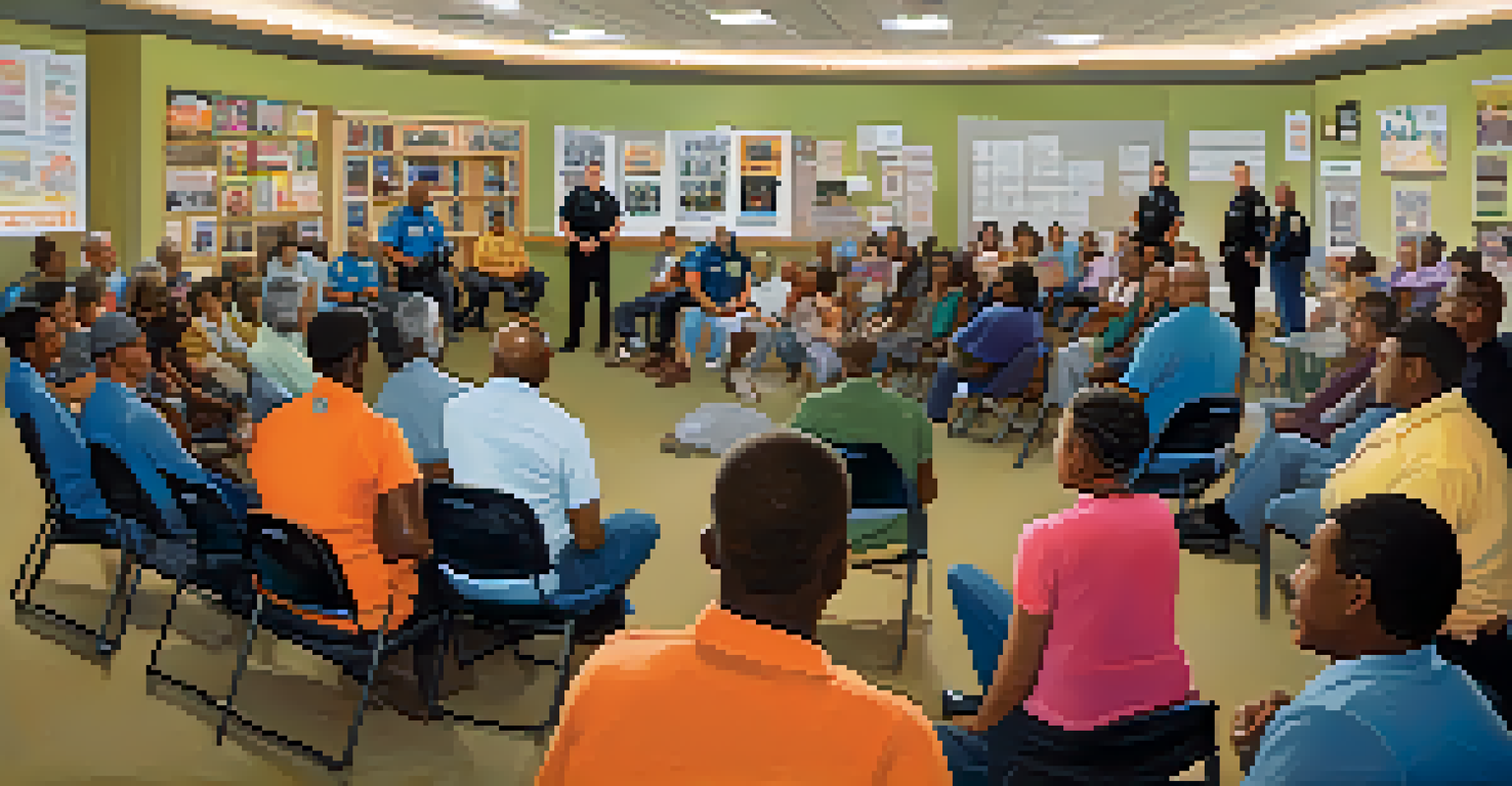Examining the Role of Community Policing in SF's Safety

Understanding Community Policing in San Francisco
Community policing is a strategy that focuses on building relationships between law enforcement and the community. In San Francisco, this approach aims to foster trust and collaboration rather than just enforcing laws. By engaging with residents, officers can better understand local concerns and tailor their efforts to address them.
The police must work in partnership with the community to be effective.
This model encourages police to become familiar faces within neighborhoods, rather than just figures of authority. For example, officers might attend community meetings or local events, creating opportunities for dialogue. Such interactions help break down barriers and promote a sense of shared responsibility for safety.
Ultimately, community policing is about shifting the perception of law enforcement from an 'us vs. them' mentality to a partnership. This shift is crucial in a diverse city like San Francisco, where varying perspectives and experiences shape community dynamics.
Building Trust Through Engagement
One of the key facets of community policing is the emphasis on trust-building. When community members see police officers as allies, they're more likely to report crimes and provide vital information. This trust is cultivated through consistent engagement, where officers listen actively to residents' concerns and feedback.

For instance, initiatives like neighborhood watch programs empower residents to take an active role in their safety. By working together, police and community members can identify issues such as drug activity or vandalism, enabling quicker responses. This collaborative effort not only helps solve problems but also enhances the overall sense of security.
Community Policing Builds Trust
Engaging with residents fosters trust and collaboration between law enforcement and the community.
Moreover, trust can help mitigate tensions that sometimes arise between law enforcement and communities of color. Through open dialogues and community forums, police can better understand the historical context of these issues and work towards rebuilding that trust.
The Impact of Community Policing on Crime Rates
Research shows that community policing can lead to a decrease in crime rates. By fostering relationships with residents, police can gain insights into local problems and develop targeted strategies. This proactive approach often results in a more timely and effective response to criminal activity.
Community policing is a philosophy that promotes organizational strategies that support the systematic use of partnerships and problem-solving techniques.
In San Francisco, community policing has been linked to reductions in certain types of crime, such as petty theft and vandalism. When communities feel connected and engaged, they are more vigilant, which can deter potential offenders. Furthermore, the visibility of officers in neighborhoods reassures residents and discourages criminal behavior.
However, it's important to note that community policing is not a magic bullet. It requires ongoing commitment and adaptability from law enforcement agencies to be truly effective. By continuously evaluating strategies and involving community feedback, the police can refine their approach to meet changing needs.
Challenges Facing Community Policing Initiatives
Despite its benefits, community policing faces several challenges in implementation. One significant hurdle is the historical mistrust between certain communities and law enforcement, which can take time and effort to overcome. Building genuine relationships requires consistent effort and transparency from police officers.
Additionally, limited resources can hinder the effectiveness of community policing. Officers may be stretched thin, making it difficult to engage deeply with the community. Striking a balance between law enforcement duties and relationship-building is crucial for success.
Technology Enhances Policing Efforts
Utilizing technology improves communication and helps police identify crime trends effectively.
Finally, community policing efforts must be inclusive of all voices, especially marginalized groups. Ensuring that everyone feels represented and heard is vital for creating a truly safe and supportive environment.
Success Stories of Community Policing in SF
San Francisco has seen several success stories that highlight the positive impact of community policing. For instance, the Tenderloin district has benefited from initiatives that focus on outreach and support for vulnerable populations. Officers working in this area have collaborated with local organizations to provide resources and assistance to residents.
Another example is the Mission District, where community policing has led to improved relations between police and residents. Through regular outreach events, officers have been able to engage with the community, leading to increased trust and cooperation. These efforts have helped address crime while fostering a sense of community spirit.
These success stories demonstrate that when police and communities work together, they can achieve meaningful change. By focusing on collaboration, San Francisco is paving the way for a safer, more connected city.
The Role of Technology in Community Policing
Technology plays an increasingly vital role in community policing by enhancing communication and engagement. Tools like social media allow police to share information quickly and receive feedback from residents. This two-way communication fosters transparency and keeps communities informed about local safety issues.
Additionally, crime mapping technology helps law enforcement identify hotspots and allocate resources more effectively. By analyzing data on crime trends, police can implement targeted strategies that address specific concerns. This proactive approach not only enhances public safety but also builds community trust.
Collaboration is Key for Success
Successful community policing relies on ongoing collaboration between police, community organizations, and residents.
However, it's essential to balance technology use with personal interaction. While digital tools can aid communication, they should not replace the face-to-face connections that are so critical in community policing. Finding that balance is key to maintaining strong community relationships.
Future Directions for Community Policing in San Francisco
Looking ahead, community policing in San Francisco is likely to evolve as the city faces new challenges. Issues such as homelessness, mental health crises, and public safety concerns will require innovative solutions. Continued collaboration between police, community organizations, and residents will be crucial in addressing these complex problems.
Furthermore, ongoing training for officers in cultural competency and community engagement will help ensure that policing strategies remain effective and relevant. As the city diversifies, understanding and respecting different cultural perspectives will be vital to building trust.

Ultimately, the future of community policing in San Francisco depends on a shared commitment to creating a safe and inclusive environment. By prioritizing collaboration and adaptability, the city can continue to enhance safety and foster a sense of belonging for all residents.